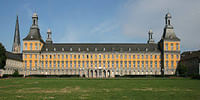- As a scientific discipline, Indo-European studies draw conclusions about this common basic language, the so-called Uro-Germanic, from the traditional Indo-European daughter languages and reconstruct it in its various aspects (phonetic system, grammar, vocabulary, syntax).
- At the same time, linguistic appearances of the individual daughter languages can be explained from the Urindo-Germanic and the subsequent linguistic developments, which include the Germanic, Romanesque, Balto-Slavic, Indo-Iranian and Celtic languages as well as the Greek.
- All of this is possible because linguistic changes do not take place arbitrarily, but in certain areas according to the same rules that are determined by Indo-European studies.
Master of Arts [M.A] (Comparative Indo-European Linguistics)
2 years
On Campus
German
₹33,000/Yr
€312 /Yr
Important Dates
| Event | End Date |
| Application Deadline For 2024 Intake | Jul 15, 2024 |
Fees & Funding
Tution & Application Fees
| Year | Year 1 | Year 2 | Year 1 | Year 2 | Year 1 | Year 2 |
| Tuition Fees | ₹33000 | ₹33000 | ₹33000 | ₹33000 | ₹33000 | ₹33000 |
| Total Fees | ₹33000 | ₹33000 | ₹33000 | ₹33000 | ₹33000 | ₹33000 |
Eligibility & Entry Requirement
- If Student is attending to"Studienkolleg", in order to prepare for the university assessment exam.
- Students need to take a DSH-Exam (German as a Foreign Language exam).
-
In order to be able to start the master's degree, a successfully completed first degree (usually a bachelor's degree in geography or a comparable degree) is required.
Course Guides
MA in Germany: Tuition Fees for 2023, Top Universities, Job Opportunities, Scholarships
Ask your question
Similar Colleges You Might Be Interested In
- Similar Colleges
No Ratings Found!!
Follow
No Ratings Found!!
Follow
No Ratings Found!!
Follow
No Ratings Found!!
Follow
No Ratings Found!!
Follow








.png?tr=h-40,w-40,c-force)

